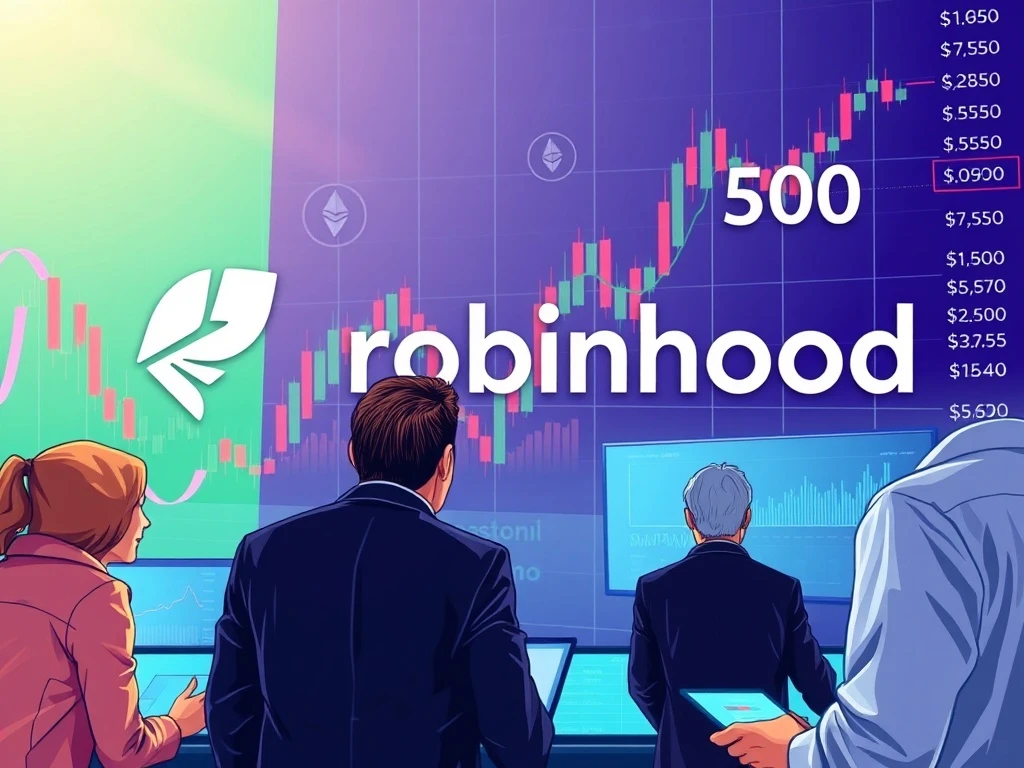Robinhood S&P 500 Debut: Unleashing Crypto’s Transformative Reach for Investors

The financial world recently witnessed a significant milestone: Robinhood’s S&P 500 debut. This event extends the reach of digital assets into the portfolios of traditional index investors, marking a pivotal moment for the cryptocurrency industry. For those deeply invested in the crypto space, this move signifies growing mainstream acceptance and increased liquidity. It directly impacts how institutions, pension funds, and passive investors engage with the burgeoning digital economy.
Robinhood S&P 500 Inclusion: A Game Changer
Robinhood Markets officially joined the S&P 500 on September 22, replacing Caesars Entertainment. This inclusion, announced by S&P Dow Jones Indices, brings another crypto-adjacent company into America’s most tracked stock index. Consequently, the benchmark index’s exposure to the crypto sector has significantly expanded. This development is not merely a stock market rebalancing; it represents a deeper integration of digital assets into the broader financial system. Edwin Mata, co-founder and CEO of tokenization platform Brickken, highlighted this shift. He told Crypto News Insights, “This movement expands the index’s exposure and connection to the digital asset economy.”
While the S&P 500 still lacks direct holdings in cryptocurrencies, Robinhood’s role as a prominent retail crypto gateway means the index indirectly captures part of the sector’s growth value and liquidity. The company’s shares experienced a significant surge following the announcement, reflecting investor confidence. This market reaction underscores the perceived value of such inclusions. Therefore, the financial implications are substantial, impacting both the company and the broader market.
Accelerating Crypto Adoption Through Mainstream Channels
The addition of Robinhood to the S&P 500 serves as a powerful catalyst for broader crypto adoption. By including companies like Robinhood, the index inherently introduces digital assets to a wider audience. This audience includes individuals who primarily invest through traditional index funds or retirement accounts. Agne Linge, head of growth at decentralized onchain bank WeFi, noted the importance of this. He stated, “The addition of Robinhood to the S&P 500 shows that crypto-related businesses are now considered strong pillars of America’s market.”
The impact extends beyond retail investors. Following Robinhood’s joining the S&P 500, all index funds and exchange-traded funds (ETFs) tracking the benchmark are mandated to add HOOD to their holdings. This requirement injects a surge of passive capital into the stock. This mechanism ensures that even the most conservative portfolios now hold a stake in a company deeply connected to the crypto market. Consequently, this passive investment flow validates the increasing relevance of digital asset platforms within established financial frameworks.
The Rise of Institutional Crypto Exposure
The S&P 500 inclusion of Robinhood directly contributes to increased institutional crypto exposure. Pension funds, large endowments, and other institutional investors often adhere to strict investment mandates. These mandates typically limit their holdings to well-established, liquid assets. By having crypto-facing companies like Robinhood and Coinbase within a major index, these institutions gain indirect exposure to the digital asset market without directly holding volatile cryptocurrencies. This offers a more palatable entry point for risk-averse entities.
Linge further elaborated on this benefit. He explained, “It also gives great exposure to normal people who only bought index funds playing safe, to pension funds, and of course to institutions who now can get comfortable with crypto exposure through one of the main basic investment tools such as the S&P 500.” This strategy allows institutions to participate in the growth of the digital economy while managing their risk profiles. It represents a significant step towards bridging the gap between traditional finance and the innovative crypto sector.
Coinbase S&P 500 Inclusion: Paving the Way
Robinhood does not stand alone in this regard. Coinbase S&P 500 inclusion occurred earlier, in May, setting a crucial precedent. Coinbase, a leading cryptocurrency exchange, was the first pure-play crypto company to join the index. Its entry signaled a growing acceptance of digital asset businesses by mainstream financial arbiters. Together, Robinhood and Coinbase now represent two key access points to digital assets within the S&P 500. This dual presence significantly amplifies the index’s connection to the crypto market.
The combined influence of these two firms means that a substantial portion of the global investment community now has some level of exposure to the crypto ecosystem. This exposure is critical for long-term market development. It normalizes the presence of crypto in investment portfolios. Moreover, it encourages further exploration and understanding of digital assets among traditional investors. This strategic positioning solidifies crypto’s place in the evolving financial landscape.
Understanding Digital Asset Exposure and Market Dynamics
While the inclusion offers significant benefits, it also introduces new dynamics. Both Coinbase and Robinhood exhibit relatively high beta values. Beta measures an investment’s volatility or systematic risk relative to the overall market. Coinbase has a beta of 2.89, and Robinhood’s is 2.36. Higher beta values typically suggest greater volatility. Linge acknowledged this potential increase in risk for the S&P 500. He stated, “The inclusion of both of these stocks that have exposure to crypto increases some risk — a marginal risk — to the S&P 500 because both of these stocks have high beta values.”
However, Linge also suggested that this tradeoff could ultimately benefit long-term index holders. Increased digital asset exposure, even with higher volatility, can offer substantial growth potential. Investors seeking exposure to innovative, high-growth sectors often accept higher beta. This strategic inclusion allows passive investors to participate in the upside of the digital economy. Consequently, the S&P 500 becomes a more dynamic and forward-looking index, reflecting evolving market trends.
Robinhood’s Expanding Ecosystem and Future Outlook
Beyond its crypto offerings, Robinhood continues to expand its financial services. CNBC’s Jim Cramer praised Robinhood following its S&P 500 addition, calling it a “juggernaut.” He highlighted the company’s continuous growth across various financial products. These include:
- Stocks and options trading
- Cryptocurrency trading
- Retirement accounts
- Credit cards
Cramer lauded Robinhood as a rare disruptor that Wall Street initially underestimated. Now, he argues, it is impossible to ignore. He remarked, “It just came out of nowhere, and it’s killing it.” This comprehensive approach to financial services strengthens Robinhood’s position as a diversified fintech company. Its continued innovation ensures its relevance in a rapidly changing market. Therefore, the S&P 500 gains exposure not just to crypto, but to a versatile platform reshaping retail finance.
Navigating Risks and Rewards: The Broader Implications
The inclusion of crypto-adjacent companies in the S&P 500 carries both opportunities and challenges. On the one hand, it legitimizes the digital asset space, attracting more capital and talent. It also offers a pathway for mainstream investors to participate in a high-growth sector. On the other hand, the inherent volatility of crypto markets could, in theory, transmit some instability to the broader index. Regulatory uncertainty surrounding cryptocurrencies also remains a factor. However, the S&P Dow Jones Indices committee conducts thorough evaluations, ensuring companies meet stringent criteria for inclusion.
The ongoing evolution of the financial landscape necessitates adaptability. Traditional indices must reflect these changes to remain relevant and representative of the economy. The S&P 500’s embrace of firms like Robinhood and Coinbase indicates a forward-thinking approach. This approach acknowledges the irreversible trend towards digitalization in finance. Consequently, investors can anticipate a more dynamic and technologically integrated investment environment.
The Path Forward for Crypto in Mainstream Indices
The Robinhood S&P 500 debut marks a significant milestone in the journey of digital assets into mainstream finance. Alongside Coinbase, these companies provide a crucial bridge between traditional investment vehicles and the burgeoning crypto economy. This increased digital asset exposure within one of the world’s most influential indices underscores a fundamental shift. It signals a future where crypto-related businesses are not just niche players but integral components of the global financial system.
As the market continues to mature, further integration of digital assets into traditional financial products and indices seems inevitable. This trend promises to unlock new investment opportunities for a diverse range of investors. It also paves the way for greater innovation and stability within the digital asset space. The future of finance is increasingly intertwined with technology, and these S&P 500 inclusions are a clear testament to that reality.









